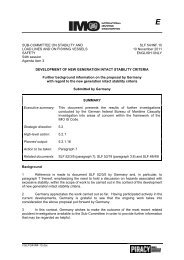Examination of the intact stability and the seakeeping behaviour
Examination of the intact stability and the seakeeping behaviour
Examination of the intact stability and the seakeeping behaviour
You also want an ePaper? Increase the reach of your titles
YUMPU automatically turns print PDFs into web optimized ePapers that Google loves.
6 Detailed examination<br />
The evaluation discussed in chapter 5 discloses, that fur<strong>the</strong>r investigations are necessary for <strong>the</strong><br />
better underst<strong>and</strong>ing <strong>of</strong> <strong>the</strong> high transversal acceleration problem. For this reason <strong>the</strong> following<br />
detailed examinations are carried out.<br />
At rst, <strong>the</strong> inuence <strong>of</strong> <strong>the</strong> ship's <strong>stability</strong> on <strong>the</strong> transversal accelerations is analysed. Fur<strong>the</strong>rmore<br />
it has to be examine, if <strong>the</strong> large vessels, Vessel No. 11 <strong>and</strong> Vessel No. 15, are also<br />
endangered to encounter high acceleration <strong>and</strong> rolling angle values in a loading condition similar<br />
to <strong>the</strong> one <strong>of</strong> Vessel No. 14 (Chicago Express) when it experienced severe ship motions in<br />
accident.<br />
6.1 Variation <strong>of</strong> <strong>the</strong> GM values<br />
In this chapter <strong>the</strong> inuence <strong>of</strong> <strong>the</strong> initial <strong>stability</strong> (namely GM) on <strong>the</strong> occurring transversal<br />
acceleration for three out <strong>of</strong> <strong>the</strong> 15 examined vessels is determined. In order to consider <strong>the</strong><br />
probable inuence <strong>of</strong> <strong>the</strong> ship's size, a small, a mid-sized <strong>and</strong> a large vessel are chosen.<br />
Based on <strong>the</strong> ballast arrival loading condition, <strong>the</strong> value <strong>of</strong> GM solid is varied by changing <strong>the</strong><br />
vertical center <strong>of</strong> gravity KG <strong>of</strong> <strong>the</strong> vessel. The calculations are performed without considering<br />
<strong>the</strong> inuence <strong>of</strong> free surfaces, for <strong>the</strong> reasons named in chapter 3.6. The displacement as well as<br />
<strong>the</strong> ship's trim <strong>of</strong> <strong>the</strong> analysed ballast arrival condition are kept constant. For each GM value<br />
all three accident situations according to chapter 3.12 are simulated.<br />
In addition it is estimated, if such a GM solid or respectively KG value is achievable from a<br />
technical point <strong>of</strong> view. For instance a total ship's center <strong>of</strong> gravity KG at height <strong>of</strong> <strong>the</strong> inner<br />
bottom is not realistic. The feasible minimum KG depends on <strong>the</strong> light ship's vertical center <strong>of</strong><br />
gravity, <strong>the</strong> position <strong>and</strong> lling <strong>of</strong> <strong>the</strong> ballast water <strong>and</strong> fuel oil tanks in <strong>the</strong> lower part <strong>of</strong> <strong>the</strong><br />
ship as well as cargo in <strong>the</strong> holds.<br />
A shifted GM directly aects <strong>the</strong> <strong>seakeeping</strong> behavior. Hence to represent well <strong>the</strong> dierences,<br />
a new set <strong>of</strong> transfer functions (RAOs) according to chapter 2.1.1 has to be calculated for each<br />
GM value.<br />
6.1.1 Small vessel<br />
Vessel No. 13 was chosen as smallest vessel for <strong>the</strong> detailed <strong>stability</strong> analysis. Its relevant data<br />
are listed in table 6.1. More main dimension data <strong>of</strong> this vessel can be found in <strong>the</strong> appendix A.13<br />
on page 71. The GM is varied around <strong>the</strong> ballast arrival GM solid = 6.98 m within a range <strong>of</strong><br />
about GM ∼ = 3 ... 12 m.<br />
In gure 6.1 <strong>the</strong> resulting transversal accelerations on <strong>the</strong> bridge are shown related to <strong>the</strong><br />
dierent GM solid values. All three accident situations result in a comparable curve slope. In<br />
accident situation 1 <strong>and</strong> 2 <strong>the</strong> highest accelerations occur for <strong>the</strong> GM value <strong>of</strong> <strong>the</strong> ballast arrival<br />
loading condition. In accident situation 3 <strong>the</strong> highest acceleration occurs for a higher GM <strong>of</strong><br />
about 8 m. With a higher or a lower <strong>stability</strong> <strong>the</strong> vessel would experience signicantly smaller<br />
accelerations. Though just a GM solid value <strong>of</strong> 8 ... 9 m is realistically reachable for this vessel by<br />
e.g. lling ballast water in tanks in low positions. Higher values in this simulation can only be<br />
reached by decreasing <strong>the</strong> vertical center <strong>of</strong> gravity <strong>of</strong> <strong>the</strong> lightship weight, which is considered<br />
being impossible for an existing vessel.<br />
47

















